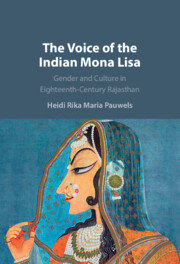Book contents
- The Voice of the Indian Mona Lisa
- The Voice of the Indian Mona Lisa
- Copyright page
- Contents
- Figures
- Acknowledgments
- Note on the Text
- Abbreviations
- Introduction
- 1 The Making of the “Indian Mona Lisa”
- 2 The Queen and the Slave Girl
- 3 Becoming the Prince’s Concubine
- 4 Synergies of the Literary Couple
- 5 Legacy: Self-Fashioning and Its Limits
- Conclusions
- Appendix: Sources
- References
- Index
1 - The Making of the “Indian Mona Lisa”
Published online by Cambridge University Press: 17 August 2023
- The Voice of the Indian Mona Lisa
- The Voice of the Indian Mona Lisa
- Copyright page
- Contents
- Figures
- Acknowledgments
- Note on the Text
- Abbreviations
- Introduction
- 1 The Making of the “Indian Mona Lisa”
- 2 The Queen and the Slave Girl
- 3 Becoming the Prince’s Concubine
- 4 Synergies of the Literary Couple
- 5 Legacy: Self-Fashioning and Its Limits
- Conclusions
- Appendix: Sources
- References
- Index
Summary
Chapter 1 identifies and analyzes the discourses that went into the “Indian Mona Lisa” trope. It qualifies the painting’s formal label, Portrait of Radha–Kishangarh (referring to the goddess, Krishna’s favorite), and informal one “Bani Thani” (referring to the purported model of the portrait, a concubine of the crown prince). It does so first by situating the painting among contemporaneous Mughal and Rajput Women Portraits. Further, it traces art-critical discourses surrounding the discovery of the Kishangarh School of Art during colonial times and the nationalist appropriation of the painting as an emblem for Rajput spiritual art, apotheosized in the issuing of a stamp. It describes the search for a model behind the painting, the protestations of this theory, and the painting’s current role in a popular cyber-orientalist love story.
Keywords
- Type
- Chapter
- Information
- The Voice of the Indian Mona LisaGender and Culture in Eighteenth-Century Rajasthan, pp. 20 - 63Publisher: Cambridge University PressPrint publication year: 2023

